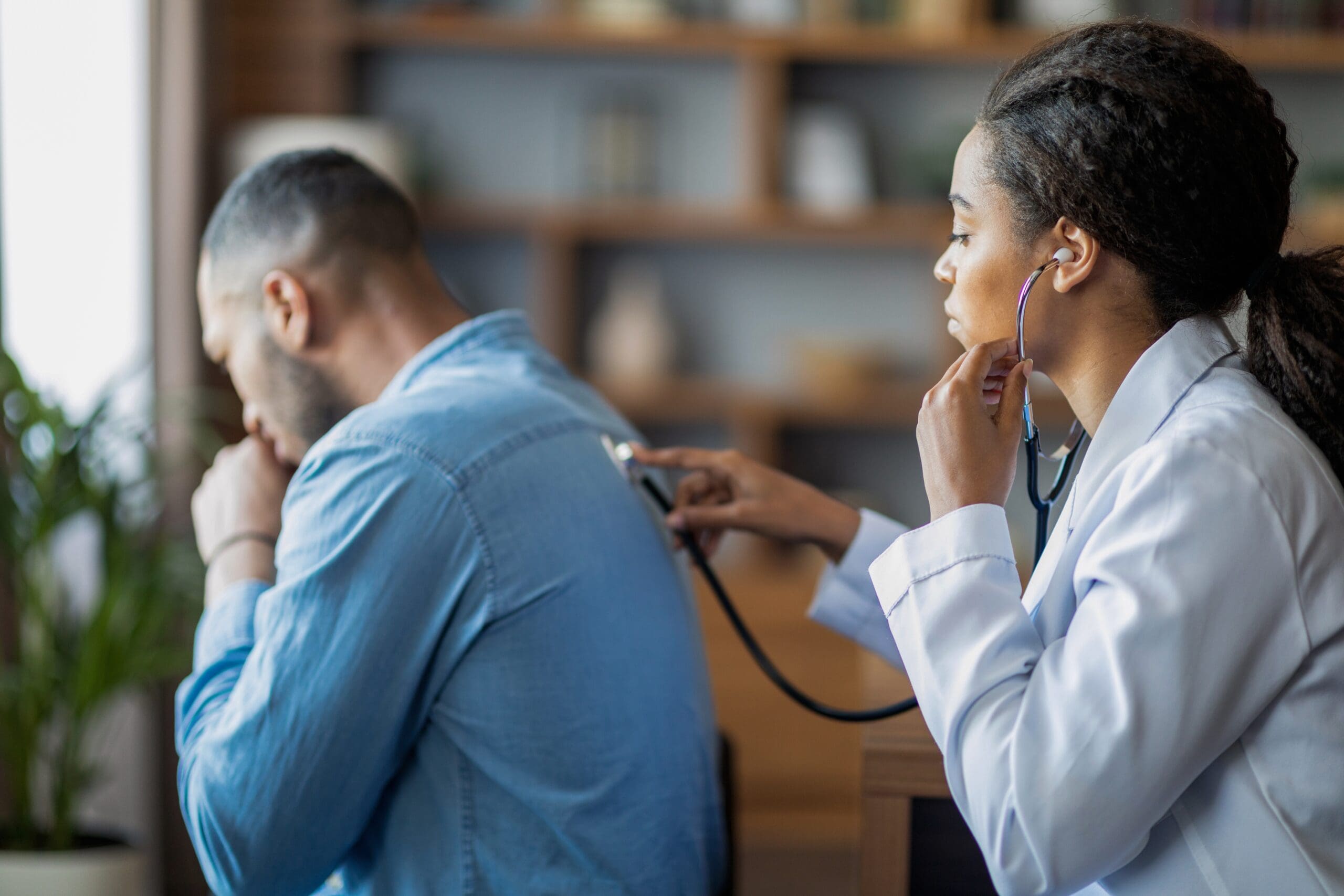In the Black or African American community, Black men have the highest reported deaths from lung cancer. Keep reading to learn more about the disease and how we can be proactive about our lung health.
What is Lung Cancer?
Lung cancer is a disease where unhealthy cells in the lungs grow out of control. Rare cancers appear in the chest wall. There are some cancers that start in other organs and spread to the lungs, but these are not considered lung cancers. Lung cancers start in the lungs.
Small masses of tissue, also known as nodules, in the lungs can be non-cancerous or cancerous. These are typically found when a person is getting a check-up for symptoms like abdominal pain or an injury.
Most people are diagnosed with lung cancer around age 70, although some cases have been found in people younger than age 45.
Although lung cancer is the second most common type of cancer seen in men and women, it kills more people each year than any other type of cancer.1,2
What are Signs and Symptoms of Lung Cancer?
If you’re diagnosed with cancer earlier rather than later, you have a much better chance that your treatment will be more effective.3 It’s important to see your physician when you first notice symptoms, instead of waiting. Your actions may make the difference in having an early diagnosis.
Just because you show some of the symptoms of lung cancer, it doesn’t mean that you have cancer. It’s important that you see your doctor as soon as you start noticing symptoms so they can determine if your symptoms are the result of cancer.
Here are some common symptoms seen in lung cancer3:
- Hoarseness
- A cough that does not go away or gets worse
- Coughing up blood or rust-colored spit or mucus
- Shortness of breath
- Chest pain that gets worse with coughing, laughing or deep breathing
- Unexplained weight loss
- Feeling tired or weak
- Infections such as bronchitis and pneumonia that won’t go away or keep coming back
- New cases of wheezing
If lung cancer has spread to other parts of the body, you may also experience:
- Back or hip pain
- Headache, weakness or numbness in the arm or leg, dizziness, balance problems, or seizures
- Yellowing of the skin and eyes
- Swelling of lymph nodes in the neck

Know What Puts You at Risk of Lung Cancer
Smoking is known to be common in the majority of people who die from lung cancer.5 However, exposure to second-hand smoking, harmful substances, like air pollution or radon, having a family history of lung cancer, or radiation therapy to the chest can all increase your chances of getting lung cancer.4,5 As with many types of cancers, the earlier lung cancer is detected, the higher the chances of surviving. Screening is important and recommended in people with a history of smoking or who currently smoke.
Smoking
Tobacco smoking is the number one cause of lung cancer. 80-90% of lung cancer deaths in the United States result from cigarette smoking.4,5 The more packs a day you smoke and the longer you smoke, the greater your risk of developing lung cancer.
People who smoke are 15 to 30 times more likely to develop lung cancer or die from lung cancer than people who do not smoke.Tobacco smoke is made up of thousands of chemicals, including at least 70 substances that are known to cause cancer. Some of the chemicals found in tobacco smoke include formaldehyde, arsenic, carbon monoxide, and ammonia.6
Cigar smoking, pipe smoking, and menthol cigarette smoking increases your risk for lung cancer almost as much as cigarette smoking.
No matter how long you’ve smoked cigarettes, quitting smoking can lower your risk for developing lung cancer than if you continue to smoke. From the moment after you smoke your last cigarette, your body starts having positive changes.
Radon
The Environmental Protection Agency estimates that radon is the number one cause of lung cancer among non-smokers. About 21,000 people die each year from lung cancer caused by radon.7,8 More than 10% of those deaths occurred in people who never smoked, which is why it’s important to get your home’s radon levels measured.
Asbestos4
If you work in a mine, mill, textile plant, shipyard or another place where insulation is used, you are more likely to die of lung cancer.
According to the American Cancer Society, asbestos exposure is less common today than it was in the past. Government regulations have decreased the amount of asbestos used in commercial products. Asbestos may still be present in older homes and buildings, but it’s not harmful unless it is released in the air by demolition or renovation.
How Does Lung Cancer Affect Black Communities?
People of color who are diagnosed with lung cancer have worse outcomes than White individuals living in America. Black individuals with lung cancer are less likely to be diagnosed early, less likely to receive surgical treatment, more likely to not receive any treatment, and less likely to survive 5 years after diagnosis compared to white individuals.9
Testing for Lung Cancer and Available Options
If you are a smoker, especially if you have smoked at least 1 pack per day for the past 30 years, you should get an annual lung cancer screening. These tests have been shown to catch lung cancer earlier than waiting for symptoms to appear. Check out this video with more information on screening options and who should receive testing.
For more information about lung health, join our NOWINCLUDED lung health circle.
References
1. Siegel Rebecca et al. (2020) Cancer Statistics 2020 https://acsjournals.onlinelibrary.wiley.com/doi/10.3322/caac.21590
2. American Cancer Society (2024) Key Statistics for Lung Cancer https://www.cancer.org/cancer/types/lung-cancer/about/key-statistics.html
3. American Cancer Society (2024) Signs and Symptoms of Lung Cancer https://www.cancer.org/cancer/types/lung-cancer/detection-diagnosis-staging/signs-symptoms.html
4. Centers for Disease Control. (2024) Lung Cancer Risk Factors https://www.cdc.gov/lung-cancer/risk-factors/index.html
5. American Cancer Society (2024) Lung Cancer Causes, Risks, and Prevention https://www.cancer.org/cancer/types/lung-cancer/causes-risks-prevention/risk-factors.html
6. American Cancer Society (2024) Harmful Chemicals in Tobacco Products https://www.cancer.org/cancer/risk-prevention/tobacco/carcinogens-found-in-tobacco-products.html
7. The Environmental Protection Agency (2024) Health Risk of Radon https://www.epa.gov/radon/health-risk-radon
8. Field William R et al. (2000) Residential Radon Gas Exposure and Lung Cancer: The Iowa Radon Lung Cancer Study https://academic.oup.com/aje/article-lookup/doi/10.1093/oxfordjournals.aje.a010153
9. American Lung Association (2023) Lung Cancer Racial and Ethnic Disparities https://www.lung.org/research/state-of-lung-cancer/racial-and-ethnic-disparities
You Might Also Like:

5 Things Hurting Your Gut Microbiome
The gut microbiome influences digestion, immunity, and even mood. Modern lifestyles can disrupt your balance. Learn how to maintain optimal gut health with these tips.

5 Black Male Artists Championing Health & Wellness
From Kendrick Lamar to Pharrell Williams, these Black male artists are dismantling stigmas, fostering open conversations, and inspiring their audiences to prioritize mental, emotional, and physical well-being.









